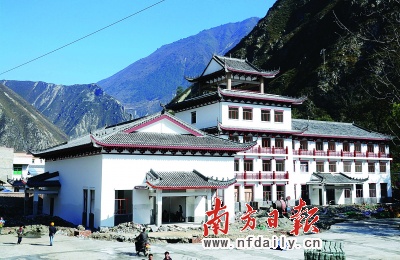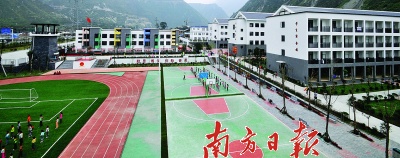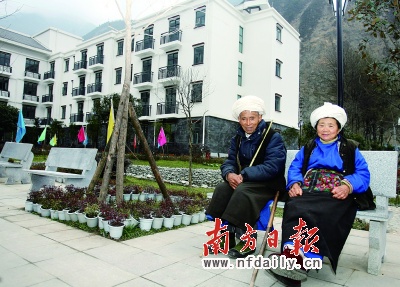Rich town, poor town
"They may come and go, but our gratitude lasts for the rest of our lives," said Jiang Zhihui, magistrate of Miansi Town, Wenchuan County, Sichuan Province. His thanks goes to the people of Zhuhai City, thousands miles away in Guangdong Province. Generous and timely aid from the coastal city lifted the rural town out of the shambles of the 2008 earthquake, and what's more, has catapulted its development to a level that would have taken 20 years under normal circumstances.
 |
| The Culture Center of Miansi Town, Wenchuan County, Sichuan Province. |
Strides made in infrastructure construction
In the wake of the May 12 earthquake in Wenchuan in 2008, the State Council worked out a plan that requires 19 provinces and cities in more prosperous eastern and central China to assist quake-blighted areas by matching them one-to-one. The program runs for three years, and the annual amount of aid required was set at no less than one percent of the giving province or city's revenue from the previous fiscal year.
Under this policy, 13 cities in Guangdong Province are tied to 13 towns in Wenchuan, and the total financial support from them is expected to reach RMB 8.2 billion.
Miansi, 18 kilometers southwest of Wenchuan, was the administrative center of the county before 1952, and 60 percent of its residents are of the Qiang ethnic minority. Among the worst affected in the 2008 earthquake, the community was almost entirely leveled. Zhuhai city was selected to help the town in its reconstruction efforts. It funded 55 major projects in the region worth of RMB 340 million, and 88 percent of those were linked to livelihood-related sectors.
According to Chen Renfu, head of the Reconstruction Work Panel of Zhuhai, priority has been given to ten sectors - schools, hospitals, orphanages, homes for the aged, public culture facilities, village centers, the drinking water supply, village roads, irrigation works, and utilities for new settlements. "When we did the planning, we tried to make public services and resources evenly and fairly dispersed across the region. Our goals are not pie-in-the-sky. All we want is to have local life back to normal, and move on," said Chen.
 |
| Miansi Primary School |
 |
| Miansi Welfare Center |
"The arrival of aid teams gave hope to local communities, and warmed people's hearts with the message that whenever a region is in trouble in this nation, help will immediately come its way from all quarters." Jiang Zhihui believed that the instant and lavish support from the rest of the nation not only alleviated the losses of quake victims and soothed their minds, but also instilled the courage and confidence to start a new life.
Li Xupeng, a section chief of the Reconstruction Work Panel, personally visited all of the 14 villages in Miansi, including the eight up in the mountains. As almost all roads were ruptured in the earthquake, for every expedition he and his colleagues made they had to alternate the dangerous traversing of slushy slopes with arduous treks on rugged cliffs. In many cases they didn't realize the risks they had taken on until they looked downward. Mercifully, they were often too tired to give another thought of their fears.
When building drinking water supply facilities, surveyors had to commute on foot between villages and their nearest water resources, ranging from a couple to a dozen kilometers away. As an aid worker from Zhuhai joked, the workload of aid teams is measured by the steps taken by their members. Now 114.7 meters of paved roads connecting Miansi’s villages have been completed.
A learning process
In the past the majority of funds for disaster-stricken areas came from the central treasury. Given the magnitude of the devastation of the Wenchuan earthquake, the state demanded contributions from local governments for Wenchuan as a supplement to the central allotment. The one-on-one aid system was initiated in the late 1970s, and at first focused on economic development only. In past decades it has taken on multiple dimensions, expanding to all aspects of society, including culture, education, technology and personnel exchanges.
Western regions have long lagged behind their eastern peers in economic development, particularly after the inauguration of opening-up and reform. The per capita GDP in the west is merely two thirds of the national average, and less than 40 percent of the eastern average. Statistics from 2007 indicate that the GDP of Foshan City in Guangdong Province is five times of that of Qinghai Province. Despite of increased inputs into the west since the Western Development Drive was launched 10 years ago, the gap between the east and the west keeps growing.
 0
0 






